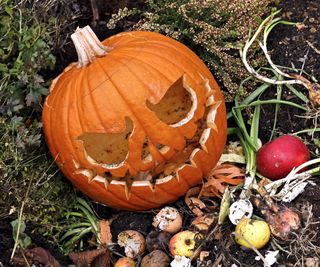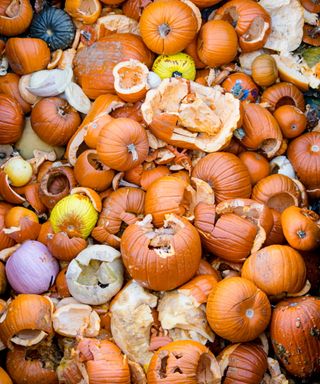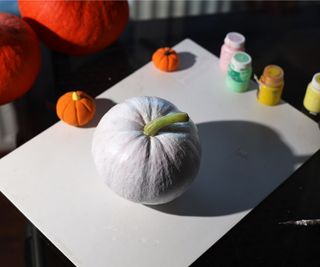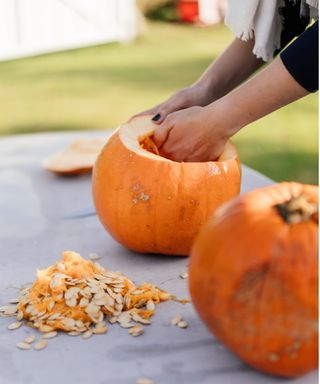It’s not surprising to hear millions of pumpkins end up in the bin once the Halloween celebrations come to an end and we start taking down our fall decorations for another year. However, compost experts urge gardeners to not be so quick to discard pumpkins and gourds that have served a decorative purpose up until this point.
When it comes to making compost, it can be tricky to know what you can and can’t put in your compost bin. The good news is, if you grow pumpkins and grow gourds of weird and wonderful colors and patterns for your fall porch, you can repurpose these crops as compost ingredients.
By the time we reach the end of the fall season, our decorative pumpkins have started to rot after standing out in wet and cold weather and might have even been attacked by pests. It’s easy to take one look and assume they need to go in the bin. But, don’t underestimate what you can still get out of these worse-for-wear crops. Here, experts tell how to compost pumpkins correctly so you can make nutrient-rich compost for your plants and prevent these fall crops from going to waste.

(Image credit: jose sanchez / 500px via Getty Images)
How to compost pumpkins
Not only is composting pumpkins a sustainable way to repurpose food waste, but pumpkins also provide valuable nutrients to a compost heap.
‘Pumpkins are especially beneficial for compost due to their high moisture content and the wealth of nitrogen and minerals within them, such as potassium and phosphorus,’ says Lauren Click, founder of Let’s Go Compost. ‘These nutrients make pumpkins an excellent green component in compost, enriching the pile and supporting microbial life essential for decomposition.’
However, some of the biggest compost mistakes include not properly preparing your materials and putting the wrong things in. Here, experts have shared which parts of the pumpkin to compost and how exactly to do it.
Which parts of the pumpkin can be composted?

(Image credit: Cindy Shebley via Getty Images)
‘Every part of a pumpkin – skin, flesh, stem, and seeds – can be composted effectively when properly prepared, transforming into nutrient-rich organic matter for gardens and landscapes,’ says Lauren.
This means you don’t have to be too strict about which parts of the pumpkin make it into your compost bin, however, it is important to know what counts as a green ingredient and what counts as a brown ingredient. One of no-dig expert Charles Dowding’s composting tips is to make sure you get this balance right – you should aim for 3/4 green and 1/4 brown ingredients in your compost bin.
‘The flesh of the pumpkin, being fibrous and water-dense, is a green ingredient that readily breaks down when layered with dry, carbon-rich materials like fallen leaves, cardboard, or straw. This balance between nitrogen (green materials) and carbon (brown materials) is critical for creating an environment conducive to microbial activity,’ explains Lauren.
Getting this balance right speeds up composting and helps to stop compost smelling bad. Unlike pumpkin flesh, the stem of the pumpkin often counts as a brown material for its woody nature.
‘While pumpkins themselves are the primary focus, composting their leaves can also be highly beneficial. Pumpkin leaves, which are abundant in nitrogen and moisture, are also a valuable green component for compost piles,’ Lauren says.
Having plenty of nitrogen sources in your compost not only aids microbe activity, but nitrogen is good for plants and a nitrogen-rich compost will support vegetative growth.

Lauren is the founder of Let’s Go Compost, a 501(c)(3) non-profit with a mission to make composting free and accessible throughout the United States. Lauren works both in the dirt (literally) with public schools and community gardens, while also remaining focused on the big picture – working with large organizations and policymakers to ensure composting accessibility and affordability are kept front of mind as infrastructure is developed.
How to prepare your pumpkin for composting

(Image credit: AHPhotoswpg via Getty Images)
Pumpkins will indeed decompose over time if left in a compost bin whole. However, to make your compost bin more effective, it’s best to prepare the different parts of your pumpkin in different ways. This is especially true for separating the green and brown elements of this crop.
‘Cut up a pumpkin into a handful of pieces for quicker decomposition. The smaller the pieces the better,’ advises Colleen Falicki, founder of Back to Earth Compost. Doing so exposes a larger surface area of each piece, speeding up the decomposition process.
It’s also wise to shred up other green materials of the pumpkin – the leaves and seeds. ‘While seeds can sprout if left whole, chopping them can prevent unwanted germination and speed up breakdown,’ notes Lauren.
Likewise, when you pick pumpkin off the vine, take the woodier stem and cut the end at an angle to expose a larger surface area before adding it to your compost pile. Cut up your pumpkin materials easily with something like this hori hori knife from Amazon.
Of course, you should incorporate your pumpkin materials with other unusual compost ingredients to ensure you maintain the correct green-brown balance.
‘Excessive green matter can create a wet and compact environment that may slow down the decomposition process,’ warns Lauren. ‘For best results, compost pumpkin leaves in moderation and combine them with an ample supply of brown materials to maintain an ideal carbon-to-nitrogen ratio.’
If you’re keen to use pumpkin leaves in your compost but have an abundance of green materials already, it is possible to still make use of them.
‘To turn pumpkin leaves from a nitrogen-rich green component into a carbon-rich brown one, they can be dried before adding to the compost pile. Drying reduces their moisture content and effectively alters their composition, allowing them to contribute as a balancing agent for nitrogen-heavy materials,’ Lauren explains.
Make sure to distribute your pumpkin pieces evenly so that you don’t disturb the structure of your compost pile.

Colleen founded Back to Earth Compost Crew in 2017 to keep food scraps out of landfill and turn it into compost. She educates about composting and advises on how to successfully compost.
Be aware of unwanted chemicals

(Image credit: Tetiana Kreminska via Getty Images)
Something to keep in mind when composting decorative fall pumpkins is the presence of any chemicals – especially if you explored pumpkin painting ideas this year. ‘Home composters should be mindful of any decorations or additions to pumpkins, such as wax from candles, glitter, or paint, which can introduce chemicals and contaminants.
‘These materials do not decompose naturally and can pose risks to soil health and quality, so it’s crucial to remove them before adding pumpkins to compost,’ warns Lauren. The same goes for commercially bought pumpkins that have been treated with chemicals and preservatives to keep them fresh for longer.
‘If you’re unsure whether a pumpkin has been treated, rinse the pumpkin with a solution of vinegar and water, scrubbing gently to remove any surface residues,’ suggests Lauren. You can also soak the pumpkin in warm water to leach out chemicals from the outer rind, she notes. If this proves to be insufficient, try peeling the pumpkin skin before putting it in your compost bin – this vegetable peeler from Walmart can help you do this.
Don’t forget to save pumpkin seeds

(Image credit: Anna Mardo via Getty Images)
Although it is possible to compost pumpkin seeds, you can extend your harvest by collecting seeds when composting your pumpkins or carving your pumpkins. ‘Rinse and save them for next year and plant a pumpkin patch,’ says Colleen.
To do this, cut your pumpkin open and spoon out the seeds before rinsing them and storing your seeds somewhere dry and cool until it’s time to plant pumpkins. This pumpkin carving kit from Amazon includes a spoon with a serrated edge that makes scooping out seeds easier.
Of course, you can also harvest pumpkin seeds to eat. ‘While pumpkin seeds are technically compostable, harvesting your pumpkin seeds is often a better option for two primary reasons,’ says Lauren.
‘First, pumpkin seeds are notorious for sprouting within compost piles, potentially leading to unintended pumpkin growth in gardens and compost heaps. Second, pumpkin seeds are rich in nutrients and serve as excellent feed for birds, squirrels, and humans,’ she notes.
FAQs
Can I put a whole pumpkin in my compost?
Yes, you can technically put a whole pumpkin in a compost heap. However, this will take a very long time to decompose. That’s why it’s recommended to cut up your pumpkin before putting it in the compost bin. Smaller pieces will decompose at a faster rate and it can help you achieve even layers in your compost bin, as a whole pumpkin takes up much more space.
How long does it take for pumpkins to decompose
This depends on factors such as how old the pumpkin is, if it has been treated with chemicals, and if it is decomposing whole or cut up into small pieces. For a compost heap, it is recommended to cut up your pumpkin. Untreated small pieces of pumpkin in a compost heap can break down in as little as eight weeks. Whole pumpkins may only start to decompose after eight to 12 weeks.
Composting is just one of the many things you can do with leftover Halloween pumpkins – depending on what state they’re in, you can also cook with them or even make a face mask. Whatever you choose to do, repurposing your decorative pumpkins is a great way to practice eco-friendly garden ideas this fall.
After Halloween, many pumpkins end up in the trash. However, compost experts advise against discarding pumpkins and gourds used for decoration. These crops can be repurposed as compost ingredients for your garden.
Pumpkins are valuable additions to compost due to their high moisture content and nutrient-rich composition. They provide essential nutrients like potassium and phosphorus, supporting microbial life necessary for decomposition.
When composting pumpkins, it’s important to properly prepare the materials and understand which parts can be composted. The skin, flesh, stem, and seeds of pumpkins can all be effectively composted, enriching the soil with organic matter.
It’s recommended to cut pumpkins into smaller pieces for quicker decomposition. Shredding the leaves and seeds can also help speed up the breakdown process. Balancing green and brown materials in your compost pile is crucial for optimal decomposition.
Be mindful of any chemicals present on pumpkins, especially if they were used for decorations. Remove wax, glitter, or paint before composting. Additionally, save pumpkin seeds for planting or consumption.
Composting pumpkins is a sustainable way to repurpose food waste and create nutrient-rich compost for your garden. By following these tips, you can prevent decorative pumpkins from going to waste and contribute to a healthier garden ecosystem.
